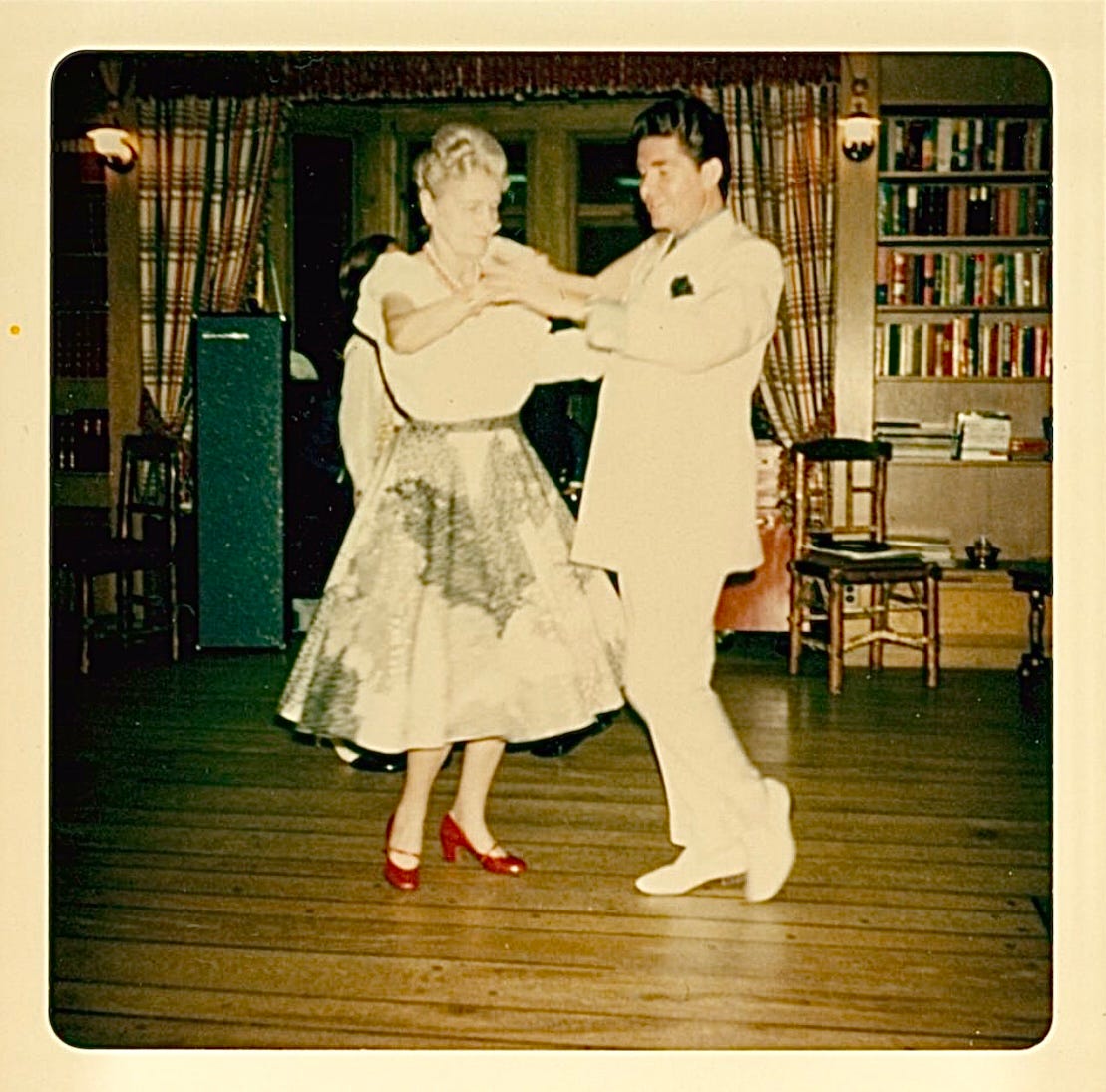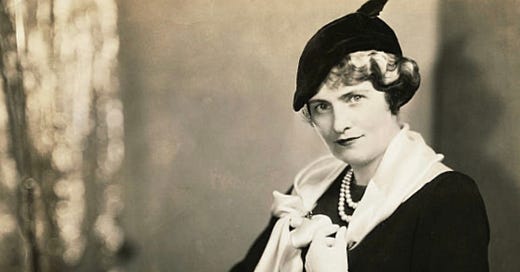Time Travel Kitchen
She changed the landscape of American food forever. A new book reimagines the extraordinary life of Marjorie Merriweather Post
She also had a signature dessert that she always made for guests. And, Marjorie loved to dance.
Marjorie Merriweather Post is someone whose life has always fascinated me. When I read a while back that bestselling author Allison Pataki was working on a new book with Marjorie as the subject of a meticulously researched historical novel, I reached out to her.
The Magnificent Lives of Marjorie Post was released earlier this week and I’ve only put it down long enough to finish this newsletter.
Allison graciously accepted an invitation to answer some questions about her book and her subject and I’m really happy to be able to share that exchange with you today.
I’ve also invited noted food historian Sarah Wassberg Johnson to give her thoughts and a snapshot of Marjorie Post’s life as an introduction. Sarah consulted on the History Channel’s The Food That Built America and Marjorie Post figures prominently in the series and the history.
And, as always, there will be dessert —with history. This week, in the spirit of Allison’s book, I’ll reimagine Marjorie’s signature dessert, with recipe, at the end of this post.
So, let’s dance!

An Introduction by Sarah Wassberg Johnson
Marjorie Merriweather Post was really ahead of her time.
When her father, C.W. Post died by suicide in 1914 after decades of poor health, he left the breakfast cereal empire he built in an effort to cure his illness to his only child, Marjorie. At 27-years-old she became Chairman of the Board of the Postum Cereal Company in Battle Creek, Michigan.
Although women’s roles had been changing during the Progressive Era, few, if any women held the same kind of financial power as Marjorie, and certainly none as young as she was.
She was not afraid to speak her mind or take risks. Her investment in Clarence Birdseye’s innovative methods of freezing foods revolutionized how Americans eat.
Through savvy acquisitions, she built her father’s breakfast cereal company into General Foods, buying up major American brands including Hellman’s, Baker’s Chocolate and Jell-O.
Under her tenure, Postum Cereal and later General Foods weathered two world wars and The Great Depression.
She became one of the richest women in America and gave away millions over her lifetime. She retired as Chairman of the Board of General Foods in 1958 (becoming chairman emeritus).
She was married—and divorced—four times, and had three children. Her third husband, Joseph E. Davis, was the Ambassador to the Soviet Union in the 1930’s, where she fell in love with Russian art. She lived life on her own terms, and played largely by her own rules.
She died in 1973 at age 86 —her obituary in the New York Times took up almost the entire page — having changed the landscape of American food forever.
Thank you, Sarah!
The Magnificent Lives of Marjorie Post: An Interview with Author Allison Pataki
Q: Allison, thank you so much for this and congratulations on the book. What drew you to Marjorie Post as the subject of your historical novel?
A. Everything Marjorie Merriweather Post did was on a grand, epic scale. This applied to her personal life with her love stories and relationships, it applies to her as a leader of American society and business, it applies to her legacy as a philanthropist and a collector. But where this really struck me was in visiting her homes. Marjorie built and lived in iconic homes like Camp Topridge and Mar-a-lago. But where I got a really deep sense of Marjorie as both a private and public individual was when I visited her home, Hillwood, in Washington, D.C. Entering the estate, which is now a museum, you can’t but be struck by the fact that Marjorie Merriweather Post was a larger-than-life individual and her story is so compelling and complicated and inspiring. And yet, many people, don’t know much about her.
Q. In your research, what surprised you most about her life?
A. So many things! Without giving away too many plot spoilers, I’ll mention just a few. The first: Post’s many meaningful connections to myriad U.S. Presidents and members of various European Royal families. I also have to mention the purported link between Marjorie and one of my favorite novels, The Great Gatsby.
But the biggest surprise has to do with the many ways she revolutionized the American way of life, particularly as that relates to our relationships with meals and our food.
It blew my mind that Marjorie was such a visionary, and also how impactful she was—even though so few people know the fascinating backstory of her empire and legacy!
Q. If you could have dinner with her today, what questions would you ask her?
A. I would be so curious to ask about her role as a mother and about her relationships with her three daughters.

Depending on how candid we were getting, I’d also be so fascinated to learn more about her marriages and what her thoughts were on the epic and tragic love stories she lived through.
And then, of course, I’d have to ask her about her time in Moscow, hanging out with the likes of Molotov and climbing through piles of the Tsar’s treasures.
Q. What’s the first word that pops into your head when you think of her?
A. Intrepid
Marjorie lived every day with meaning and a determination to make the most of her gifts and opportunities.
Q. What do you hope readers take away after reading your book?
A. I hope readers will be inspired by all Marjorie did in her life and walk away with a deeper appreciation for the ways she shaped history and changed life for so many.
Sometimes I joke that Marjorie Merriweather Post was like the Forrest Gump of the 20th Century; she had a front row seat and was an active participant in so many of history’s great moments, only she had way better clothing!
Thank you, Allison!
A Signature Dessert
Marjorie Post’s signature dessert, Adirondack Pie, is a big stack of thin pancakes that she made herself, outdoors, after canoeing trips at Camp Topridge in New York.

Along with her family, and according to quotes from her late daughter, actor and philanthropist Dina Merrill, she’d mix the batter and flip them over in the pan while picnic blankets were set down on the lawn.
She’d place crunchy maple sugar, butter and maple syrup between each layer as she stacked them high — then cut wedges and hand out to her guests.
All who visited Camp Topridge were treated to them and by all accounts really looked forward to this ritual. Marjorie was also known to serve Jell-O at the end of fancy dinner parties, and why not? She owned it.
If you’d like to learn more about the history of this dessert, click here: Adirondack Pie
My version: Crepes à la Marjorie
Since I hadn’t been hiking or canoeing, but rather hiding indoors from freezing Chicago winter weather, I thought I’d adapt this delicious idea to something a bit lighter.
I had just seen a photo of a beautiful crepe cake made by Claire Ptak of Violet Cakes and recipes for variations which include crepes with blood oranges and maple syrup.
I didn’t have blood oranges on hand, but I did have in-season Honeybell oranges (which are a hybrid and have the sweetness of mandarins and the tartness of grapefruit). Here is the link to the article with several delicious looking recipes you may like to try: Claire Ptak’s Quick and Fool-proof Pancake Recipe.
My version:
I made unsweetened crepes
1 pint of heavy cream, lightly whipped with 2 tablespoons of good maple syrup
Thinly sliced oranges with rind removed
A friend had just given me a 1973 pamphlet cookbook of crepe recipes, so here’s the one I used, simple as can be.
Recipe
Method
I got a kick out of the very 70’s cover art design on this almost 50-year-old cooking pamphlet, a promotion for the Creative Cookware Company.
Thank you so much to Sarah and Allison for their time and for making history and the story of the magnificent Marjorie come alive!
Have a wonderful weekend, everyone. Happy reading and cooking.
Jolene
Sources and Additional Reading:
Pataki, Allison. The Magnificent Lives of Marjorie Post. New York, Ballantine Books, 2022.
Davis, Geo. “Marjorie Merriweather Post’s Adirondack Pie.” essexonlakechamplain.com, Essex, New York Community Blog, February 27, 2014.
Roberts, Roxanne. “Marjorie Merriweather Post wanted her house to be a museum. Ellen Charles made it happen. TheWashingtonPost.com, June 2, 2014.
Obituary of Marjorie Merriweather Post, nytimes.com, September 13, 1973.











Jolene, this was a super fun post -- I had no idea who Marjorie Merriweather Post was, so I appreciated the quick intro before diving into a Q&A with an author. (Such a great idea to pair things up that way!)
Speaking of breakfast cereal empires, if that interests you (don't ask me why it interests me): if you've never read T.S. Boyle's novel, The Road to Wellville, it's hilarious. It's based on Dr. John Harvey Kellogg's Battle Creek Spa... C.W. Post was a former patient and allegedly stole some of the ideas he consumed, literally and metaphorically, while at the sanatarium (including Postum!)
Lest I nerd out too hard here, let me just say this is fascinating stuff, and thank you for adding a little to my basic knowledge today!
Book and crepes? I'm there. Sold. :)